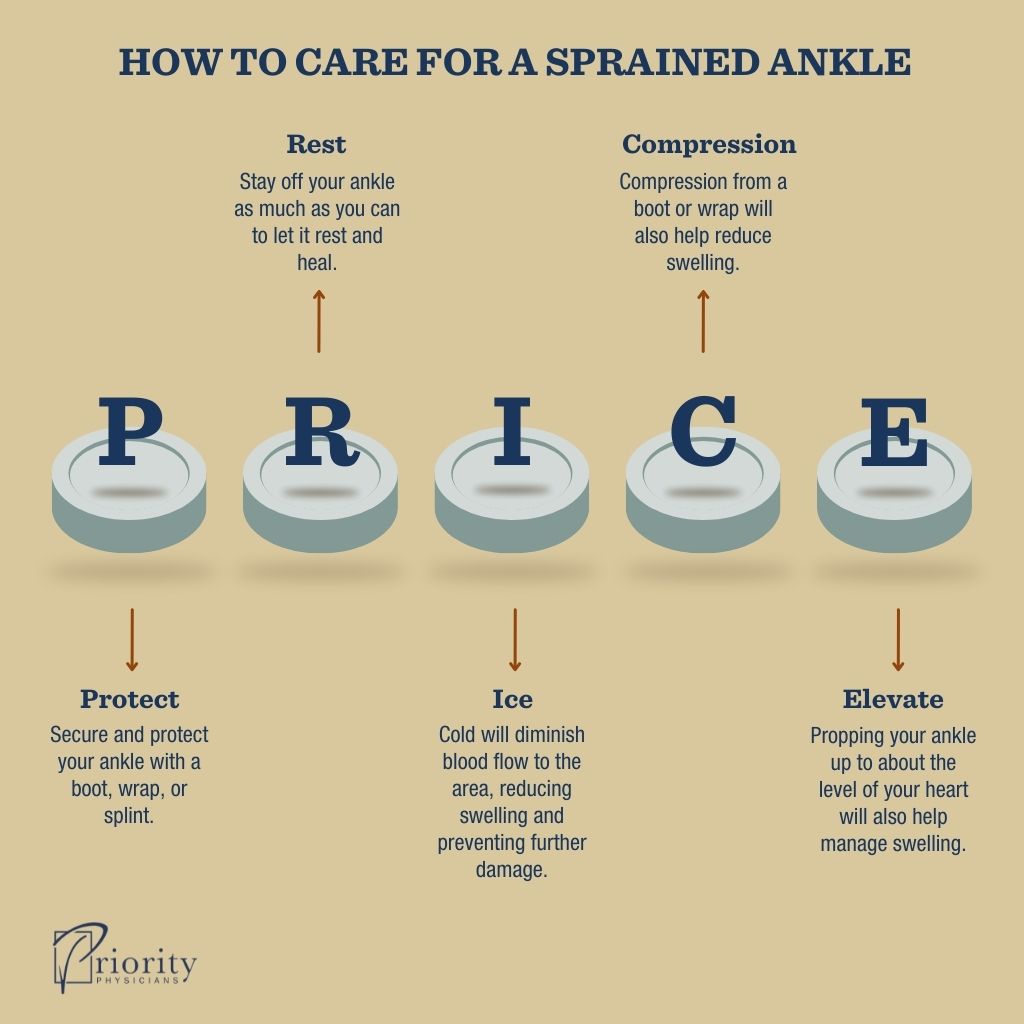Ankle sprains are one of the most common injuries managed by emergency rooms and primary care physicians. If you’re an active person, there’s a good chance you’ll experience a sprain in your lifetime.
Ankle sprains account for anywhere from 16–40% of all sports-related injuries.
Most of the time, an ankle injury is just a sprain. But sometimes it’s actually a fracture. How can you tell the difference?
In this post, we’ll look at a sprained ankle vs. a broken ankle, what symptoms to look for, and how to treat each.
Sprained Ankle vs. Broken Ankle
To make sure we’re clear on what we’re talking about, let’s first define a few terms:
- Sprain — Injury to the ligaments
- Strain — Injury to the muscles or tendons
- Fracture — Injury to the bone
Sprains account for 70–90% of all ankle injuries and are especially common among basketball, soccer, and football players. Most ankle sprains occur on the lateral side of the ankle, the same side as the pinky toe. The foot rolls over and under, injuring the lateral ligaments of the ankle. This is also called an inversion sprain.
Three ligaments support the outside, or lateral side, of the ankle. These three ligaments are much more vulnerable to sprains than the one broad, strong ligament of the medial ankle. A medial ankle sprain happens when the big toe side of the foot rolls under, causing damage to the medial ligament. This is called an eversion sprain and is much less common. However, the medial ankle is more vulnerable to fractures.
A fractured ankle could involve a dramatic break where the bone protrudes from the skin. But it could also be harder to detect, like a hairline fracture. Sometimes, an X-ray is the only way to detect a fracture.
It’s difficult to identify a sprained ankle vs. a broken ankle. Sprains can look horrible, with substantial swelling and alarming discoloration that seem to indicate severe injury. But these symptoms don’t actually tell you the difference between a sprain and a fracture. In fact, sprains often look worse than breaks.
Identifying a Sprained Ankle vs. a Broken Ankle
To help differentiate a sprained ankle from a broken ankle, physicians follow the Ottawa ankle rules. Since many people prefer to treat ankle sprains at home, these guidelines can also help you assess whether you need to see a doctor.
Ottawa Ankle Rules
The Ottawa ankle rules help reduce the need for X-rays by assessing whether an ankle injury is a sprain or a fracture. They take two main factors into consideration: pain location and weight-bearing ability.
Where does it hurt? When you look down at your ankle, you normally see a bump on either side. These bumps are the lateral (outside) malleolus and the medial (inside) malleolus.
The Ottawa ankle rules ask you to check these bony projections for tenderness. Using your fingers, gently press on and behind the malleolus of the affected side of your foot. If you experience tenderness on the bone tip or behind the bone, the next step is to see a doctor for an X-ray.
Can you walk? Even a sprain will hurt to walk on, but the Ottawa ankle rules aren’t asking about pain as much as they’re asking about ability.
The magic number here is four. If you’re unable to shift your weight and take four steps, you need an X-ray to see whether you have a fracture.
How to Care for a Sprained Ankle vs. a Broken Ankle
Many people don’t go to the doctor for a sprained ankle. And for sprains, home care is often enough. But broken ankles are a different ballgame and require care from a sports medicine doctor or orthopedic surgeon.
What to Do for Sprained Ankles
If you’re caring for a sprained ankle at home, the best thing you can do is follow the PRICE protocol:
- Protect — Secure and protect your ankle with a boot, wrap, or splint.
- Rest — Stay off your ankle as much as you can to let it rest and heal.
- Ice — Cold will diminish blood flow to the area, reducing swelling and preventing further damage.
- Compression — Compression from a boot or wrap will also help reduce swelling.
- Elevate — Propping your ankle up to about the level of your heart will also help manage swelling.
Pain management. To manage pain, you have a couple of different options. You can take a non-steroidal anti-inflammatory drug (NSAID), which includes the brand names Advil, Aleve, and Motrin, or the generic name ibuprofen or naproxen. These can help manage pain and swelling in the short term, but taking NSAIDs long term could actually impede healing and lead to other adverse side effects.
Tylenol, also known as acetaminophen, is a better option for injuries like a sprained ankle. It reduces pain and can be used long term without the side effects and risks of NSAIDs.
Rehabilitation. In the days and weeks following a sprain, rehab and strengthening are important. You should start bearing weight and walking as soon as you can tolerate it — perhaps after three to seven days, depending on severity. The longer you wait, the more stiffness and muscle atrophy will occur, causing you to lose mobility and range of motion.

What to Do for Broken Ankles
Most ankle fractures are managed by orthopedic surgeons. Sometimes, they may recommend splints, bracing, or a cast along with crutches to facilitate healing. Four to six weeks of this kind of conservative treatment is often enough to heal lateral ankle fractures, which involve the fibula.
Other times, an ankle fracture may require surgery. This involves using plates and screws to hold the ankle together while it heals. Surgery is more common for medial ankle fractures involving the tibia (the shinbone).
When Is a Sprain Not a Sprain?
Ankle injuries are tricky, so a misdiagnosis can happen. Maybe you tried the Ottawa rules and determined you had a sprain. You’ve been managing it with the PRICE protocol, but it’s been three or four weeks and you still limp or struggle to bear weight without pain.
If this is your situation, it’s time to see your doctor. If you haven’t had one, you’ll need an X-ray. You might even need an MRI if the X-ray doesn’t show the source of the problem. You could also receive a referral to a physical therapist.
The Final Word on Ankle Injuries
A lateral ankle sprain is one of the most common injuries among athletes and active people. If you find yourself with an ankle injury, remember to check for tenderness and walking ability. If you can’t bear weight, especially, you need an X-ray.
If you have a sprain, remember to PRICE — protect, rest, ice, compress, and elevate. Take some time to rest and recover, then get started on rehab as soon as you can bear it. If you’re still having problems after three to four weeks, contact your doctor for an X-ray.
It’s not easy to identify a sprained ankle vs. a broken ankle, but the guidelines in this post should give you a solid framework to start with.

